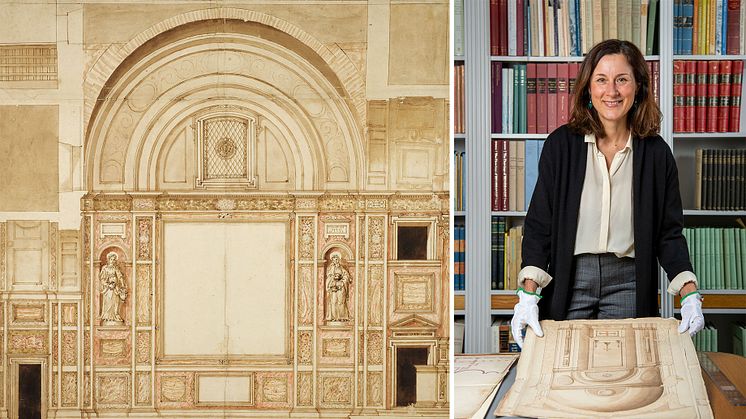
Press release -
Italian architectural drawings: research brings new discoveries
A collection of Italian architectural drawings held by Nationalmuseum was the subject of a recently completed research project. Anna Bortolozzi, associate professor of art history at Stockholm University, made a detailed study of the collection, which was once owned by the architect Carl Johan Cronstedt. By studying the drawings as material objects, using information beyond the purely visual, she made several new attributions and concluded that the collection belonged to Carlo Maderno, the most prominent Roman architect of the early baroque period.
The extensive research project examined the collection of architectural drawings that Carl Johan Cronstedt (1709–1779) purchased and brought to Sweden in the mid 18th century, which was donated to Nationalmuseum by Erik Langenskiöld in 1941. Anna Bortolozzi, associate professor of art history at Stockholm University, reviewed the collection and made a detailed study of the Italian architectural drawings within it. Previously, some of the individual drawings were studied as building plans or visual documents of a particular architect’s work, but this project involved studying the collection as a whole.
In all, the project covered 181 drawings, from the period between 1570 and 1620, by Francesco da Volterra, Carlo Maderno and other Roman architects. The drawings depict churches, chapels, palaces, gardens and fountains. The collection also contains sketches of details from classical and Renaissance buildings in Rome, drawn by visiting French architects on study tours. The theory is that Maderno, on taking over the project from his teachers, who included Domenico Fontana and Francesco da Volterra, also took over any working materials left in their studios. It is possible that these sketches of architectural details were used as working material by Maderno himself and added to the collection. This collection of Roman architectural drawings continued to grow under subsequent owners, who added a few drawings, until it ended up in Sweden in the 18th century.
Bortolozzi’s theory is supported by the fact that the same type of paper used by Maderno for his project drawings was also used to mount the studies of classical and Renaissance buildings. The mounts are not the type used by collectors, but rather an extra layer of paper as reinforcement to allow the drawings to be handled safely. This indicates that they were used as part of the architect’s working process.
A catalogue describing the research project and its reasoning, Italian Architectural Drawings from the Cronstedt Collection, Nationalmuseum, Stockholm, has been published by Hatje Cantz, a German art publisher. Besides its renowned provenance, traced back to the turn of the 17th century, the collection offers project sketches from various phases of St Peter’s Basilica and a unique project sketch of a façade for the Villa Giulia. Some of the drawings have been published before, since they constitute a unique body of material in international research on late Mannerism and the early baroque period. In Bortolozzi’s research, however, it is possible to follow the architect’s working process, as the drawings also reveal social and economic information on matters such as client–practitioner relationships and choice of materials.
The research department at Nationalmuseum manages research and digitisation projects. These projects are usually externally funded, but in some cases Nationalmuseum donates labour and expertise or makes a financial contribution from in-house funds. A number of research projects are run in partnership with universities. Staff on these projects divide their time between the museum and their normal work. Many projects result in reports published by Nationalmuseum, sometimes in partnership with other publishers.
For further information
Hanna Tottmar, Head of press, press@nationalmuseum.se, +46 8 5195 4400
Categories
Nationalmuseum is Sweden’s museum of art and design. The collections include paintings, sculpture, drawings and graphic art from the 16th century up to the beginning of the 20th century and the collection of applied art and design up to the present day. The museum building was closed for renovation for five years and reopened in autumn 2018.

